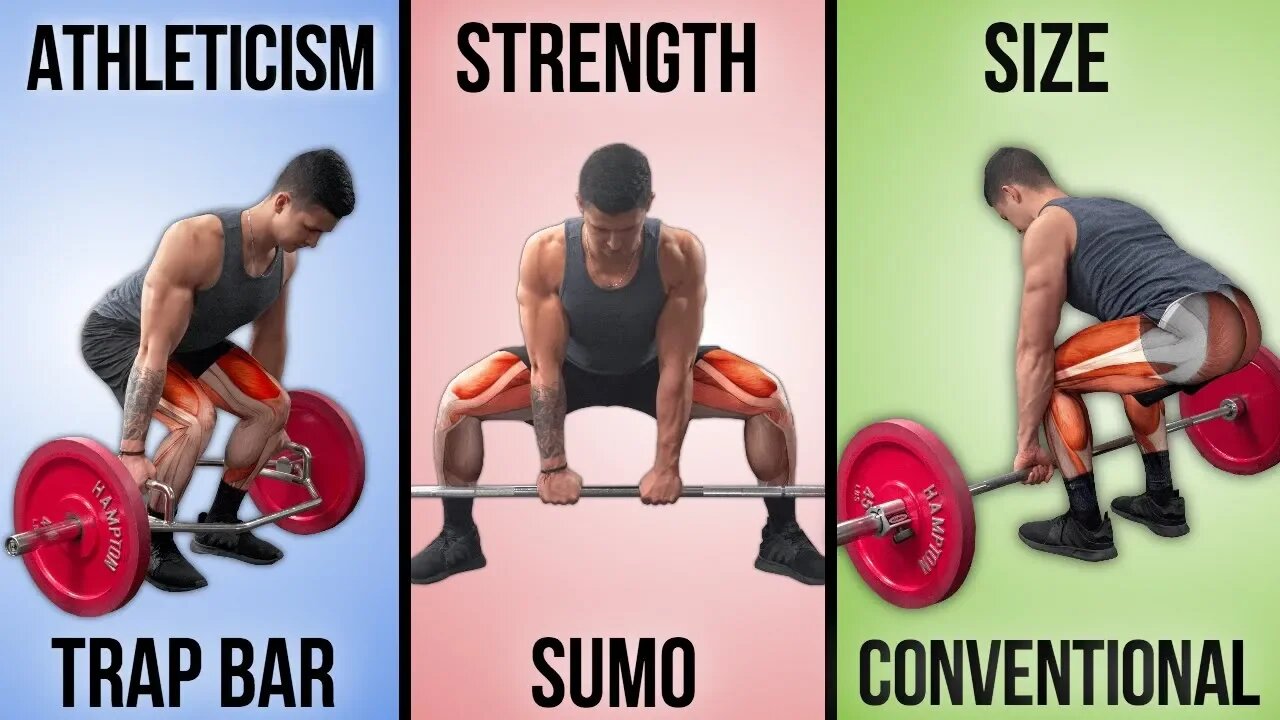Premium Only Content

What is The BEST Type of Deadlift- (CHOOSE WISELY!)
The deadlift can be argued as the single best exercise for strengthening and developing the posterior chain. And although the conventional deadlift is typically what pops into most people’s minds when they think of the deadlift, it’s important to note that there are other variations that exist; such as the sumo deadlift and the trap bar deadlift. These alternatives not only slightly vary in the muscles they work and the training adaptations they elicit, but may actually be the better option for you based on your specific anthropometry, history of injury, and mobility restrictions.
So how do you know which one is best for you? Well, let’s take a quick look at each type of deadlift.
The conventional deadlift, which is the most popular option, is characterized by a narrow foot stance with the hands placed just outside of the knees. This causes the conventional deadlift form to have a more horizontal trunk angle during the setup than the other forms of the deadlift. This also means that this deadlift will involve the greatest lower back demands and will work the lower back muscles to the greatest degree. While also having the greatest mobility requirements. If you’ve had previous lower back injuries, then the conventional deadlift may not be best for you.
The sumo deadlift, a popular alternative, is characterized by a wider foot stance with the hands placed inside the knees at about shoulder-width apart. This causes the sumo deadlift to have a more vertical trunk angle and resembling more of a squat movement than the other forms of the deadlift do. As for whether you should do the sumo deadlift vs conventional, it can be a good option since the upright angle of the setup decreases the stress placed on the lower back. It does however limit the range of motion (which can be argued as less effective for hypertrophy) while working the quadriceps more. If you struggle with conventional or would like the added emphasis on the quads, then the sumo would be the best option for you.
The trap bar deadlift, or hex bar deadlift uses a different type of bar such that you grip the bar at your sides rather than in front of you. As a result, the trunk angle is slightly more vertical than the conventional deadlift but more horizontal than the sumo deadlift. The main benefit of the trap bar deadlift vs straight bar vs sumo deadlift, is that there is the least demand on the lower back. This is because the grip handles are at your sides. In addition, this type of deadlift is the best for athletes seeking to improve their explosive performance, power output, and force production. So if you’ve had past lower back issues or want to improve your athleticism, this is the deadlift for you.
Just keep in mind that there’s not one version that’s best for everyone. Instead, it’s vital that you choose the right variations based on your specific goals and what best suits your body and your history of injury.
And if you’re looking for an all-in-one evidence-based program that does exactly that, such that you can see the fastest results possible but in a safe and detailed manner, then take the starting point quiz below to determine what program is best for you:
https://builtwithscience.com/bws-free...
LINK TO WRITTEN ARTICLE:
https://builtwithscience.com/types-of...
FOLLOW ME ON INSTAGRAM & FACEBOOK:
https://www.instagram.com/jeremyethier/
https://www.facebook.com/Jeremyethier...
FILMED + MOTION GRAPHIC EDITING DONE BY:
Abdo Megahid
Vimeo: https://www.vimeo.com/abdohmegahed
Facebook: https://www.facebook.com/abdohmegahid
Instagram: @abdohmegahed
MUSIC:
https://soundcloud.com/lakeyinspired
STUDIES:
Higher quadriceps activation for sumo deadlift & trap bar deadlift:
https://www.ncbi.nlm.nih.gov/pubmed/1... https://www.ncbi.nlm.nih.gov/pubmed/2...
Spinal extension demands higher for conventional deadlift:
https://www.ncbi.nlm.nih.gov/pubmed/1...
Greater ROM for conventional deadlift:
https://www.ncbi.nlm.nih.gov/pubmed/1...
Trap bar deadlift best for athleticism:
https://www.researchgate.net/publicat...
https://www.ncbi.nlm.nih.gov/pubmed/2...
https://www.ncbi.nlm.nih.gov/pubmed/2...
-
 2:33:58
2:33:58
TimcastIRL
13 hours agoDan Bongino ACCEPTS Deputy FBI Director, SECRET NSA CHATS EXPOSED w/Joey Mannarino | Timcast IRL
185K99 -
 1:09:33
1:09:33
Glenn Greenwald
17 hours agoMichael Tracey Reports from CPAC: Exclusive Interviews with Liz Truss, Steve Bannon & More | SYSTEM UPDATE #412
135K95 -
 56:02
56:02
Sarah Westall
13 hours agoBiohacking & Peptides: Weight loss, Anti-Aging & Performance – Myth vs Reality w/ Dr. Diane Kazer
76.3K33 -
 11:22
11:22
Bearing
23 hours ago"Anxious & Confused" Federal Workers FREAK OUT Over DOGE Efficiency Email 💥
100K79 -
 1:31:20
1:31:20
Flyover Conservatives
1 day agoUS STOCK MARKET: Sinking Ship - Dr. Kirk Elliott; How I Fought Back Against Woke Schools & Stopped Gender Bathrooms - Stacy Washington | FOC Show
90.9K5 -
 1:08:09
1:08:09
Donald Trump Jr.
18 hours agoFBI Dream Team, Plus Taking Your Questions Live! | Triggered Ep.219
234K304 -
 7:32:37
7:32:37
Akademiks
17 hours agoDrake and PartyNextDoor '$$$4U' Album Sells 250K first week. BIG AK IS BACK.
140K19 -
 3:12:08
3:12:08
MyronGainesX
16 hours ago $34.01 earnedDan Bongino Named FBI Deputy Director, Trump Meets Macron, And More!
114K37 -
 3:12:31
3:12:31
vivafrei
16 hours agoBarnes Live from Seattle - Defending Benshoof in a Case that is CRAY CRAY!
211K58 -
 2:12:12
2:12:12
Robert Gouveia
16 hours agoLiberals EXPLODE over Elon's Email; Lawsuits FLY; Sanctions?? Congrats Dan!
143K92